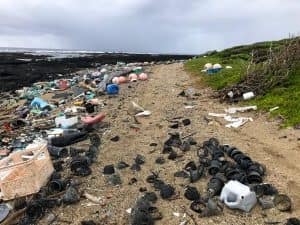Eroding Plastics Revealed Source Greenhouse Gases - Arhive
Eroding Plastics Revealed as Source of Greenhouse Gases Eroding Plastics Revealed Source Greenhouse Gases

Sarah-Jeanne Royer holding microplastics at Kamilo Point on Big Island. Credit: SOEST IPRC. Sarah-Jeanne Royer holding microplastics at Kamilo Point on Big Island. Credit: SOEST IPRC. Sarah-Jeanne Royer holding microplastics at Kamilo Point on Big Island. Credit: SOEST IPRC.
Researchers tested common plastics used to make food storage, textiles, construction
materials and various plastic goods including polycarbonate, acrylic, polypropylene, polyethylene terephthalate, polystyrene, high-density polyethylene and low-density polyethylene (LDPE).
Polyethylene—used in shopping bags—is the most produced and discarded synthetic polymer and the world, and was found emit the highest amounts of both gases.
Researchers also found the rate of gases emitted from virgin pellets of LDPE increased during a 212-day experiment. Once initiated by solar radiation, the emission of these gases continued in the dark.Eroding Plastics Revealed Source Greenhouse Gases
“We attribute the increased emission of greenhouse gases with time from the virgin pellets to photo-degradation of the plastic, as well as the formation of a surface layer marked with fractures, micro-cracks and pits,” said lead author Sarah-Jeanne Royer, a postdoctoral scholar at the Center for Microbial Oceanography: Research and Education (C-MORE) at the time of this investigation.Eroding Plastics Revealed Source Greenhouse Gases
“With time, these defects increase the surface area available for further photochemical degradation and therefore contribute to an acceleration of the rate of gas production.”

Plastic pollution at Kamilo Point, Big Island. Photo credit: Sarah-Jeanne Royer.
Smaller particles, termed “microplastics,” form in the environment as plastics degrade and may be further accelerating gas production.
“Plastic represents a source of climate-relevant trace gases that is expected to increase as more plastic is produced and accumulated in the environment,” said David Karl, senior author on the study and SOEST professor with C-MORE. “This source is not yet budgeted for when assessing global methane and ethylene cycles, and may be significant.”Eroding Plastics Revealed Source Greenhouse Gases
Greenhouse gases directly influence climate change, affecting sea level, global temperatures, ecosystem health and storms, which increase flooding, drought and erosion.
“Considering the amounts of plastic washing ashore on our coastlines and the amount of plastic exposed to ambient conditions, our finding provides further evidence that we need to stop plastic production at the source, especially single use plastic,” said Royer.
Plastics have been mass produced for nearly 70 years, and production rates are expected to double over the next two decades.Eroding Plastics Revealed Source Greenhouse Gases
Royer is now working to develop estimates of the amount of plastic exposed to the environment worldwide in an effort to reduce their impact on climate change.
Related Topics
